“Something was coming up behind them. What it was could not be seen: it was like a great shadow, in the middle of which was a dark form, of man-shape maybe, yet greater; and a power and terror seemed to be in it and to go before it.
It came to the edge of the fire and the light faded as if a cloud had bent over it. Then with a rush it leaped across the fissure. The flames roared up to greet it, and wreathed about it; and a black smoke swirled in the air. Its streaming mane kindled, and blazed behind it. In its right hand was a blade like a stabbing tongue of fire; in its left it held a whip of many thongs.”
-J.R.R. Tolkien, The Fellowship of the Ring
Conceptualizing Durin’s Bane for Fellowship of the Ring was one of the most arduous design challenges the artists at Weta Workshop met in the entire project. Not only were Tolkien’s descriptions of its appearance vague enough to interpret, but beyond its anatomy the creature had to channel the fundamental diptych of “Shadow and Flame” the writer assigned to it. “The Balrog took the longest to realize,” said Weta concept artist Christian Rivers, “because it had so many ethereal attributes. Even Tolkien’s description was hard to translate — a shadow blacker than black, with a mane of fire on a creature that was vaguely a shape. A man-shape? We didn’t know.”

Compared to the novel, the introduction to the Balrog is greater in scope. The crew designed the Moria Goblins’ armour to channel the appearance of the Balrog, implying that they worship it as a deity. In addition, as Durin’s Bane approaches the scene, the photography of the film leans towards progressively warmer colours.
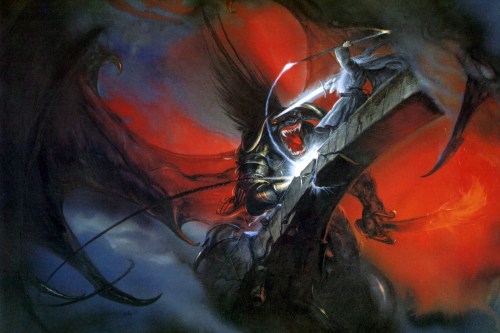

The Balrog’s ‘man-shape’ was always a defining aspect of its silhouette, and was initially taken literally — with muscular, prominently humanoid iterations. The turning point was represented by a published illustration by John Howe — made before the film’s production — which portrayed the Balrog as a more bestial and demonic creature than a simple human form, a concept that proved pivotal for the design process. The film Balrog thus steered towards a similar direction: the “man-shape” would only be suggested by the anatomy of its torso, as well as its upright and imposing posture. A mane of fire running down the creature’s neck and back was another element that was established early during the design process — as well as the ram-like horns curving downwards and forwards. Based on their interpretation of Tolkien’s writing, Jackson and crew also decided to endow the Balrog with wings — a choice stemmed from two brief passages in Fellowship of the Ring:
“[…] His enemy halted again, facing him, and the shadow about it reached out like two vast wings. It raised the whip, and the thongs whined and cracked. Fire came from its nostrils. But Gandalf stood firm.
[…]
“The Balrog made no answer. The fire in it seemed to die, but the darkness grew. It stepped forward slowly on to the bridge, and suddenly it drew itself up to a great height, and its wings were spread from wall to wall […]”
Howe commented on this choice: “Tolkien was always a little brief in his description, so people interpret it in different ways. I mean, I’ve always drawn him [the Balrog] with wings because it just seems so cool to have wings! There’s a hint of it in the book when Tolkien says, ‘there are shadows, like wings’, and frankly that was all the excuse I needed to stick wings on it. It doesn’t say they don’t have wings, so why not? That was Peter’s tongue-in-cheek approach, too! If it doesn’t say it’s not there — then we can do it!”
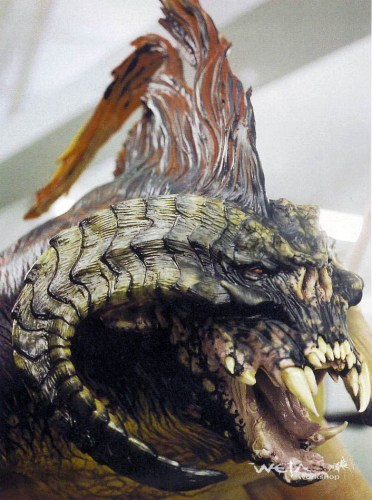
The Balrog’s look was ultimately developed progressively through a series of conceptual maquettes. Given it would obtain its ethereal appearance through digital enhancement, the Balrog also needed to be a reality-based form. Ben Wootten was the artist with the most influence in the process, being responsible for the final iteration of the design. Visual effects supervisor Richard Taylor said: “its skeletal structure was a mixture of a dog and a bull, with wings based on the structure of bat wings. It had the tail of a lizard, and its horns were fashioned to look like actual horn material.” The 4′ tall maquette depicting the final design’s head and torso was sculpted by Wootten himself and Jamie Beswarick.
Gino Acevedo’s initial colour schemes for the Balrog were based on dark but organic, animal-like patterns. However, it was ultimately established that Durin’s Bane would be a fantastic being composed of lava, taking into consideration that the Fellowship encounters it deep within a mountain. Most importantly, this expedient also resolved the question of how to convey the “Shadow and Flame” description. Scenographer Grant Major said that the demon “appears to be made of fire, of lava almost. It’s as if the environment it is in, the base of the mountain, because it is volcanic, infused in this fiery monster.” Taylor added: “the skin just happened to be congealed, cold lava. By basing it in this physical reality, the audience could believe in this fantastical, bizarre creature.” Wooten’s maquette was finally scanned to obtain a rough digital model, which was then refined manually and completed with the rest of the Balrog’s anatomical components, such as the wings.
The next challenge was to properly convey the lava-like texture of the Balrog’s body. As envisioned, the Balrog’s outer surface acted like solidified lava, containing the creature’s innards — molten lava. Taylor elaborated the concept in the commentary for the film: “we very much wanted the feeling that the surface of the Balrog was like congealed lava, and that if he [remained] still for a long time it would turn completely black — but through his actions, the lava would split, revealing a more molten mass of heated lava underneath the skin — as if his skin is running with liquid veins of heat and fire. His eyes glow like white embers and when he roars, the heat wave flows out of the inner forms of his body, where this massive energy is stored. We wanted his back to erupt into this huge flaming furnace as if all the energy is pouring off his back like a huge mane; and his wings are almost like shadows of smoke writhing around him.” Gray Horsfield also described the Balrog’s skin moving “like tectonic plates”. The Balrog’s outer surface was defined and texture-painted by Paul Campion and Rob Shrider.
The Balrog’s animation, much like the other creatures of the film, was inspired by Ray Harryhausen’s stop-motion effects. The animators also wanted the Balrog’s movements to have regality and intelligence. Animation supervisor Randall William Cook related: “the Balrog, another member of ‘the Harryhausen family’, was a huge challenge. He had to be more supernatural than just a big, dull Monster, and so we set out to give a sort of sense of regality to his movements. He had to be a Monster, but also malevolent and intelligent.”
This concept also had to be applied to the simulated fire and smoke that burst forth from the creature. “He had to be animated in a way that the fire would behave dramatically,” Cook said. Not only did the Weta crew need to devise an improved fire and smoke simulator — they also needed to find a way to give it a dramatic character. The crew chose to finalize the bulk of the animation — i.e. the Balrog’s actual body — before adding smoke and fire effects, in order to maximize the time to develop a technique to portray them properly. Cook related: “we semi-finaled the animation months before we saw smoke, which made it difficult to know exactly how much to animate. As it turned out, we put more work into the animation than we should have, given how much of the Balrog was covered up with smoke. We thought there was going to be more of a real shape, and more definable locomotion. I even had a grand theatrical notion of the Balrog carrying a tail behind him, sweeping like a train on a costume — but it ended up just smoke.”
Technical director Jim Callahan initially devised a complex physics-based fluid dynamics system and volume renderer; it was discarded because it was deemed as ‘too render-intensive’, and the fire produced with it did not behave dramatically as Jackson intended. After failed experiments in puppeteering actual gas jets, the crew settled on a combination of practical and digital effects — a system developed by Gray Horsfield. He explained: “I did a test initially, which was just a single, blobby little cell-shaped thing moving down a slope. It was on fire and it was burning. I did that using sprites, which are basically just pictures on particles. […] For the Balrog, we shot fire — explosions and propane tanks going off, flames billowing and curling around — and then we put those pictures on fairly rudimentary Maya particle systems. Each particle was a picture of fire doing its stuff. We did the same thing for smoke. In both cases, the pictures were animated, not just still, so they would evolve over time. There were a lot of these little sprite projections going, synchronized differently, and we layered them together until it looked appealing. We added fire where we felt we needed it, and took it away where it didn’t seem to be working. So basically, we were just utilizing Maya as a compositing package to reposition the pieces of fire so that they were in the right place and moving the right way.” This process considerably quickened the rendering process, allowing the crew to render two frames per second.
Jackson commented in retrospect, saying that “the hardest work by far was simply to come to that point where you can say, ‘the design is finished,’ because you never quite want to let something go, because even though it looks good, you might say ‘one more day’s work,’ and the next day you get something better. So there always has to be that point where you say, ‘okay, this is what the Balrog is going to look like, it’s finished.’ A lot of my energy and time was spent handling that process and making sure that I was happy with what we finally decided to sign on.”
“The Balrog reached the bridge. Gandalf stood in the middle of the span, leaning on the staff in his left hand, but in his other hand Glamdring gleamed, cold and white. His enemy halted again, facing him, and the shadow about it reached out like two vast wings. It raised the whip, and the thongs whined and cracked. Fire came from its nostrils. But Gandalf stood firm.
`You cannot pass,’ he said. The orcs stood still, and a dead silence fell. `I am a servant of the Secret Fire, wielder of the flame of Anor. You cannot pass. The dark fire will not avail you, flame of Udûn. Go back to the Shadow! You cannot pass.’
The Balrog made no answer. The fire in it seemed to die, but the darkness grew. It stepped forward slowly on to the bridge, and suddenly it drew itself up to a great height, and its wings were spread from wall to wall; but still Gandalf could be seen, glimmering in the gloom; he seemed small, and altogether alone: grey and bent, like a wizened tree before the onset of a storm.
From out of the shadow a red sword leaped flaming.
Glamdring glittered white in answer.
There was a ringing clash and a stab of white fire. The Balrog fell back and its sword flew up in molten fragments. The wizard swayed on the bridge, stepped back a pace, and then again stood still.
‘You cannot pass! ‘ he said.
With a bound the Balrog leaped full upon the bridge. Its whip whirled and hissed.
‘He cannot stand alone! ‘ cried Aragorn suddenly and ran back along the bridge. ‘Elendil!‘ he shouted. ‘I am with you, Gandalf! ‘
`Gondor! ‘ cried Boromir and leaped after him.
At that moment Gandalf lifted his staff, and crying aloud he smote the bridge before him. The staff broke asunder and fell from his hand. A blinding sheet of white flame sprang up. The bridge cracked. Right at the Balrog’s feet it broke, and the stone upon which it stood crashed into the gulf, while the rest remained, poised, quivering like a tongue of rock thrust out into emptiness.
With a terrible cry the Balrog fell forward, and its shadow plunged down and vanished. But even as it fell it swung its whip, and the thongs lashed and curled about the wizard’s knees, dragging him to the brink. He staggered and fell, grasped vainly at the stone, and slid into the abyss. ‘Fly, you fools! ‘ he cried, and was gone.”
-J.R.R. Tolkien, The Fellowship of the Ring

For more pictures of the Balrog, visit the Monster Gallery.

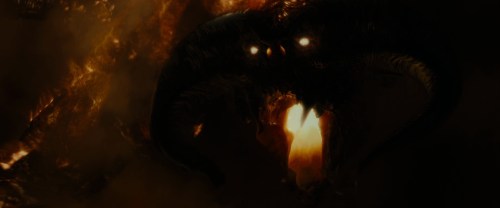
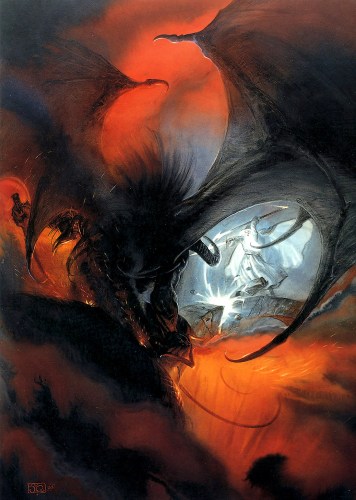
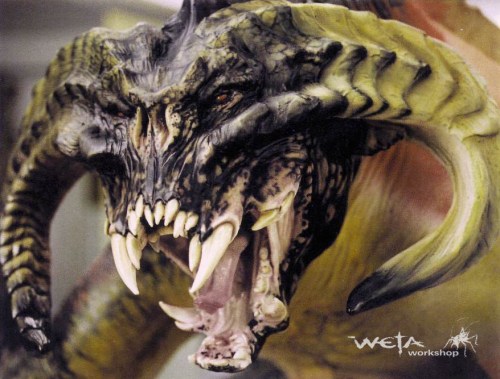


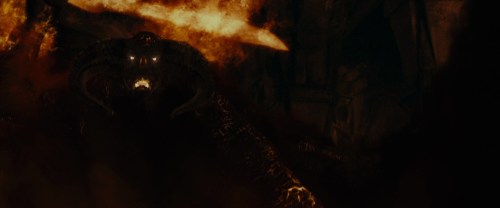


[…] Flame of Udun […]